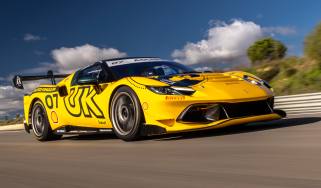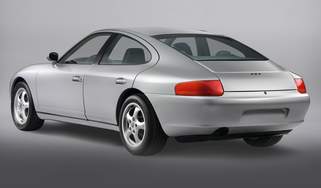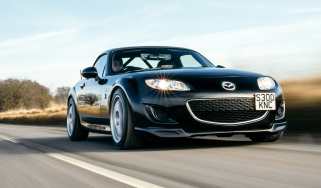Porsche 956: the anatomy of an endurance racing icon
The 956 (along with its 962 successor) represents a pinnacle of endurance racing. We look under the skin of this iconic racer to discover what made it such a legend
The Group C Porsche 956/962 of the 1980s has a stronger claim than most to be the greatest sports-racing car of all time. Consider that it turned a wheel for the first time in March of 1982, but that a derivative (the Dauer 962LM) won Le Mans outright as late as 1994. In between, it won the 24-hour race at La Sarthe six times in a row, the period equivalent of the WEC five times in a row, the American IMSA series three times, and scored so many individual race wins and regional championships that there simply isn’t the space to mention them all here.
New for 1982, the Group C regulations were centred on the use of production-based engine blocks, providing a lower cost base for potential teams and a wide variety of engines for the fans, while fuel consumption limits restricted the ultimate performance of the cars and equalised the field. The initial allocation decided upon was 600 litres for 1000km races and 2600 litres for Le Mans, although these would drop to 510/2210 litres later. Group C cars could be no longer than 4.8 metres, no wider than 2m and no higher than 1.1m. Ironically, the rulebook’s cockpit dimensions were based on those of the Porsche 917, measured in the Porsche museum. A flat reference plane, measuring a metre by 800mm, was positioned behind the front wheels, and the venturi tunnels were only allowed to begin after it. Group C cars would be ‘ground effect’ cars, but there were no sliding skirts (as found in contemporary F1) at the time of inception and their subsequent use was tightly regulated. The minimum permitted weight was initially just 800kg.
> Williams‑Honda FW11: the anatomy of a 1980s turbo F1 car
Porsche built ten ‘works’ 956 chassis for the 1982 season (according to Ultimate Works Porsche 956, the Definitive History, by Serge Vanbockryck), with an initial run of eight customer chassis, eventually running to 19 cars (including independently constructed tubs). Built in far greater numbers were the 962 and 962c. The former was initially built to satisfy the American IMSA series, the FIA and IMSA having failed to agree on uniformity of regulations. IMSA was concerned its championship would turn into another Porsche benefit and placed obstacles in the path of the 956. Firstly it outlawed the type on account of the driver’s feet being in front of the front axle line, and secondly banned its twin-turbo, partly water-cooled flat-six. When the 962 debuted at the 1984 Daytona 24 Hours its front suspension had been moved further forward (a shorter front overhang meant it retained the same overall length) and it had a single-turbo air-cooled flat-six that owed more to the one in the old 935s of the 1970s. Almost inevitably, once teething issues were overcome it would dominate the championship for years, much to the chagrin of IMSA.
The FIA and IMSA never did agree on a unified rule-set, though the FIA later introduced the same safety legislation over the front axle line, applicable for Group C from 1986 onwards. In response, Porsche took a 962, fitted a 2.8-litre development of the 956’s engine, and christened it the 962c for the world championship. The works team ran the car first in 1985, with customer cars appearing the year after, at the end of which 956s were banned from racing. From then on until the early ’90s it was all about the 962c, but that, as they say, is another story…
Chassis no. 106
Richard Lloyd was one of Porsche’s original 956 customers for the 1983 season alongside the Joest, Kremer and Obermaier teams and others, purchasing chassis no. 106 in early 1983. He went to the factory to collect it with, amongst others, his friend the renowned car designer Peter Stevens, who would act as team graphics designer, aerodynamicist and timekeeper. ‘Richard and I went with a briefcase of money,’ recalls Peter. ‘They gave him a handbook and an ignition key, which also locked the doors, and said: “Your car is downstairs in the lower floor of the garage.” It was like going to buy a 911, but less grand.’
The car cost DM640,000 (around £550,000 in today’s money) and Lloyd had arranged a budget for the season of £850,000 (£2.8m today) with sponsorship mainly from Canon cameras. A spare engine was £33,750 (£109,688), the exotic titanium road springs a grand each (£3210) and a replacement nose body section £3000 (£11,375).
As a British privateer, Lloyd’s RLR team felt it wasn’t supported in the same way that German teams such as Joest Racing were. ‘Richard was up for fiddling with the car all the time,’ recalls Peter of how Lloyd searched for an edge to keep them competitive. That meant employing designer Nigel Stroud to work on chassis improvements and Peter on the aero, spending time in the wind tunnels at MIRA and Imperial College. The results led to the little RLR team punching considerably above its weight, enjoying a string of podium finishes with the driver pairing of Jonathan Palmer and Jan Lammers throughout 1983 and into 1984, with 106 winning the 1000km of Brands Hatch outright in that second year. By then, Lloyd’s modifications had become more radical, with Stroud developing a revised monocoque that included aluminium honeycomb sections for improved rigidity. ‘If you stomped on the brake pedal the front bulkhead would bend,’ Stevens notes of the original single-skin tub. This car was known as 106b, while Lloyd sold the original 106 tub to Brun Motorsport, who continued to use it up until the end of the 1986 season when it helped them to the overall teams’ championship.
106b, with its aero tweaks such as the two-plane rear wing, front splitter (and sometimes an additional front nose wing), was a quick car, famously coming second overall at Le Mans in 1985. However, it suffered a huge accident in practice at Spa that same year that seriously injured Jonathan Palmer, and the car was eventually rebuilt with another new Stroud tub as 106b2 – that’s the car you see here. After appearing again at the end of 1985 for one last race in Canon colours, it ran with Lloyd’s new Liqui Moly sponsorship for the 1986 season, and in another competitive year claimed victory at the Brands Hatch 1000km with Bob Wollek and Mauro Baldi at the wheel before being rendered obsolete at the end of the season, like all other 956s, by the safety rule changes.
Patrick Morgan of Dawn Treader Engineering saw the car come up for auction in 2008 (after Richard Lloyd’s death in an air accident). It failed to sell, but Patrick bought the car directly from Lloyd’s widow. He then embarked on a complete restoration which for various reasons has taken 12 years but has brought the car to the superlative condition you see here.
‘Anything that’s anodised we chemically strip, polish by hand and then re-anodise to try to keep the original machining marks, which sounds pedantic but I think adds to the authenticity of the car,’ says Patrick. ‘We tried to keep as many original parts as possible, and that can involve more work than replacing. Obviously, every bearing, O-ring and seal is new. The front anti-roll bar mounts we had to remake because they were cracked. We use an aviation company to crack-test all the wishbones and uprights, which get X-rayed too as they can rust on the inside. We do the steering column and brake pedal too – anything that’s safety-critical. If you do it right the first time, although expensive, it’s cheaper than ending up in a barrier.
‘We’ve done everything in-house. The gearbox is exquisite, a synchromesh five-speed and the first racing synchro ’box I’ve been involved with: it’s like jewellery inside. The engine is typically Porsche, so anyone who’s rebuilt a 911 would recognise it.’ The car has already moved under its own steam at the airfield where Dawn Treader is based, but this year Patrick hopes to run the car in anger.
Body, chassis & aerodynamics
The 956 was Porsche’s first monocoque racing car, having always built its prototype racing cars using spaceframe construction up to this point. But it was also its first ground effect car, and the aerodynamic loads placed on the car’s structure meant a big improvement in rigidity was required over the 956’s predecessors, such as the open-cockpit 936. Nevertheless, by the time the very first 956 was nearing completion, the marque had already won Le Mans outright six times, and many of the engineers at Weissach were veterans at the very top of their game. The brilliant Norbert Singer was project leader, with Valentin Schäffer responsible for the engine, Eugen Kolb the body and Horst Reitter the chassis.
Remove all the panels and ancillaries from a 956 and you’ll see that the core of the car is a beautifully crafted aluminium teardrop-like pod. Reitter’s tub design – weighing 56kg – was made from riveted and bonded single-skin aluminium sheet: stronger and safer than anything Porsche had made before. The decision was taken to dismiss then-embryonic carbonfibre construction as it would be necessary to farm out its design and construction to a third party. Time was short, and anyway, virtually every aspect of the 956 was made at Porsche; like a Ferrari, a Porsche racing car was a true Porsche, not the case with many big brands that contracted to specialist racing car constructors.
An aluminium rollover structure was on top of the tub, with spaceframes front and rear to hold the major components. The engine was tilted up by 2 degrees at the rear so that the boxer layout didn’t interfere too much with the venturi tunnels underneath the car, but this was always a compromise of the design inherent in choosing that type of engine.
The body was designed with downforce in mind, but there was still a legacy of ‘low drag thinking’ at Porsche, and the slippery 956/962 was always fast at Le Mans, where a different nose and tail were used to prioritise top speed. Although Singer continued to spend time in the wind tunnel, the 956 and then 962 changed remarkably little in factory guise, and it was later that the 962c began to lose its integral rear wing and gain a shorter rear overhang for sprint races.
Engine, gearbox & electronics
One of Porsche’s advantages was the use of a tried and tested engine. Given Group C’s demand for production-based engine blocks, the 956 naturally used a flat-six, the 2650cc version that had won Le Mans in 1981 in the back of the 936/81 with Jacky Ickx and Derek Bell.
Porsche had adopted water-cooling in part back in 1978, and the 956’s installation continued to use that combination, with a large fan cooling the block and water doing the same job for the heads. Boost was provided by twin KKK K26 turbochargers, mounted low on the sides behind the doors, with water and oil radiators located in the same area. With a magnesium block featuring a bore and stroke of 92.3 and 66.0mm respectively, the original figures released for this engine were 620bhp at 8000rpm and 442lb ft of torque at 5400rpm with 1.2 bar of boost, mechanical fuel injection and a 7:1 compression ratio. Porsche was notoriously conservative with its quoted outputs, the accepted wisdom being that when running 1.4 bar for qualifying, the peak power would be at least 100bhp more than that quoted figure.
Developments included periodic rises in compression and, for 1983, the adoption by the works cars of Bosch Motronic injection, which was made available to customers for ’84. Perfecting the system took a lot of work, and the factory even lost races to its privateer customers while it did so, but in time it was a huge step forward in terms of maintaining power and improving the all-important economy. Porsche eventually switched to a 2.8-litre version of the flat-six for the early 962c, and this also found its way into customer 956s. In later years a fully water-cooled 3-litre engine would arrive, eventually teamed with Bosch’s more sophisticated MP1.7 injection, and late cars ran with 3.2-litre engines. Up to 900bhp was attainable during qualifying.
One of the 956’s endearing quirks (along with its use of an actual ignition key, in true Porsche racing tradition) was its synchromesh gearbox, a rarity in a pure racer. However, the factory did use a straight-cut ’box for sprints, and at the end of 1983 ran publicly for the first time a new twin-clutch gearbox known as… PDK.
PDK had its race debut in late 1984 (where it lasted just two laps), but Porsche persisted in developing the system because, as Derek Bell attests, Porsche Motorsport’s budget to go racing was based around developing technology that would be useful for the production cars. This noble viewpoint didn’t always please the driver looking for race wins, but that was what signed the cheques.
Suspension, tyres & brakes
The big Porsche was relatively conventional here, with classic double wishbones at the front end, Bilstein dampers all-round and a pushrod arrangement at the rear to keep the damper units out of the way of the venturi tunnels. Those ferociously expensive (for the time) titanium springs featured progressive characteristics.
106b2 employs Nigel Stroud’s rethink of the front suspension: instead of having the springs and dampers attached to the lower front wishbone, there is a bell-crank with a pullrod attached to the upper front wishbone, which gives the front suspension rising rate – that is, it increases the resistance the more the car dives during heavy braking.
The Porsche factory team worked with Dunlop to shod its 956s (and later 962c), although 956s ran on a variety of different tyre brands in privateer hands. Brakes were made by ATE and featured two four-pot calipers per 330mm disc, with purpose-made Speedline wheels that had built-in tyre pressure sensors, relaying information to the driver (vital for Le Mans). RLR equipped its cars with a single Brembo caliper per disc, though – another of the myriad detail changes incorporated by the team.
Driving it
Derek Bell MBE needs no introduction. Although he never drove Richard Lloyd’s 956, he did race for the team in the 962c era. However, he’s best known for his years as a Porsche factory driver, and his relationship with the 956 goes back to the first test at Paul Ricard in early 1982. ‘All I could do was compare it to the 936,’ he explains. ‘We had no experience with ground effect cars. So all I could say was: “That’s better than anything I’ve ever driven!”’
Bell chuckles, the warmth obvious in his voice: ‘It was perfect to drive. Fantastic. The power in qualifying, at 1.4 bar and an extra 500 revs, was super. The handling was immaculate. Because the car was so neutral I wanted to get the car pointing up the road as soon as possible, so as I came off the brakes I’d flick the wheel enough to break the tail away and make the corner more of a straight line. When you first start driving them they’re stable, and then as you go faster they’re nervous on cold tyres, but as the tyres come in the ground effect starts…’ Confidence was key in getting the best out of a 956. ‘It’d just lose grip naturally,’ Derek says of its breakaway characteristics. ‘I knew “the feel” – your body had to know “the feel”. The steering would load up and be heavy in tight corners.’
Running it today & the marketplace
Twenty years ago a typical customer 956 or 962c could be picked up for under £200,000, and, as Patrick Morgan recalls, back then even a Rothmans factory car was £300,000. These days it’s very different, with upwards of a million required to join the club, while a car with famous race history might be ten times that.
Naturally, these aren’t cheap cars to run. ‘The expectation is to get a minimum of 24 hours out of an engine between rebuilds,’ says Patrick, ‘but talking to others it’s close to 36 hours in reality. Reduce the boost and revs and you’re going to help yourself. To take the underwing off, you have to remove the rear lower wishbones, but everything else is very accessible. We run it on 260 GTX fuel, which is 104 octane; so as long as you’re not getting into knock, and it’s not oxygenated, you’re fine.
‘Parts are relatively straightforward. Certain parts you can get from Porsche – there are a lot of road car parts on it. Master cylinders, slave cylinders, down to nuts and bolts, are very much Porsche inventory parts, which for an endurance racer is a good, solid way to do it – very different to the single-seaters we normally work on, where every part is bespoke.’
This story was first featured in evo issue 306.
Porsche 956 specs
| Engine | Flat-six, twin-turbocharged |
| Capacity | 2649cc |
| Max power | 620bhp @ 8200rpm |
| Transmission | Five-speed manual, rear-wheel drive |
| Fuel capacity | 99 litres |
| Weight | 820kg |
| Power-to-weight | 768bhp/ton |
| Max speed | 217mph |
| Price | £149,000 (1982) |







